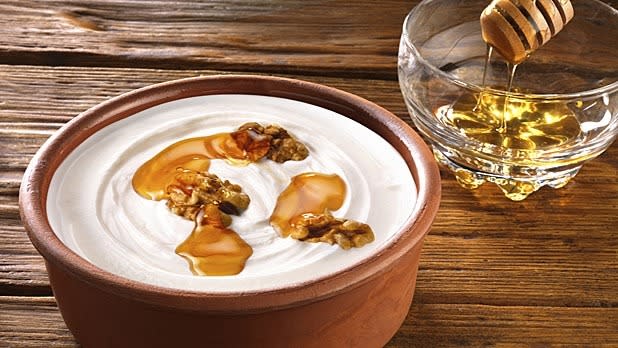How to Make Greek Yogurt at Home

(Photo Courtesy of Getty Images)
There are compelling reasons to eat Greek yogurt, which, truth be told, is really just strained yogurt. The straining removes whey liquid, endowing the yogurt with a thicker texture, fewer sugars, and less lactose than regular, unstrained yogurt. The remaining whey solids have about double the protein of regular yogurt, or 15-20 grams of protein per six-ounce container – the equivalent of three eggs. Plus, six ounces contain about 20 percent of the daily recommended calcium intake, and they have plenty of probiotics (healthy bacteria) for the health of your immune and digestive systems.
Related: The 8 Healthiest Yogurt Toppings
But some commercial strained yogurts are plied with gelatin and other thickeners, refined sugar, preservatives, and artificial colors or flavorings. In the U.S., almost all are made with cow’s milk. Plus, some are incredibly high in fat (think 10 percent) thanks to the heavy cream fortifying the whole milk in, admittedly, some of the most delicious strained yogurts. For your protection, read the label.
To ensure you’re getting the benefits of all-natural strained yogurt, consider making it yourself. Up the nutrition ante with the sheep’s or goat’s milk used in the Eastern Mediterranean, where yogurt first eased the human gut some 10,000 years ago. Sheep’s milk has 48 percent more protein than cow’s milk, plus its fatty acids have little effect on human cholesterol levels or formation of arterial plaque. As for goat milk, the proteins in this nutritionally superior milk are digested more easily than those in cow milk.
Related: The 10 Healthiest Foods for Your Gut
Leave your Greek yogurt plain and let it speak for itself – the way folks do on Crete, well known as the source of Greece’s creamiest yogurt, made from the milk of local sheep or goats who feed free range on the rocky hills. You could make tzatziki with yours. Or for a sublime breakfast or dessert, simply spoon some onto a small plate, drizzle with thick Greek thyme honey, and sprinkle with walnuts.
Strained Greek Yogurt
(Makes 1 quart)
Make the base yogurt from scratch, or buy 2 quarts high-quality commercial yogurt and start straining at Step 5. Straining will reduce the volume by half; nonfat yogurt, by even more.
2 quarts milk, preferably sheep’s milk
4-quart metal, heavy-bottom saucepan or enamel-coated Dutch oven
Candy thermometer
Large glass bowl
4 tablespoon yogurt starter with live cultures
Whisk
Large strainer (with front prongs so it can sit on bowl)
2 squares of cheesecloth or tea towel for straining
Get out pan/Dutch oven and milk. You can use any kind of milk, from nonfat to full fat; sheep or goat milk produce the thickest yogurt and that’s what’s in strained yogurt in Greece. The cow’s milk used in the U.S. produces thinner strained yogurt. For best results, the milk needs to be as fresh as possible.
Related: 10 Bad Foods That Get a Healthy Rap
Heat milk to scalding in saucepan or Dutch oven (preferable), just until bubbles form around edge. Do not boil. Remove from heat, and with candy thermometer, make sure it’s 170°F–180°F. Cool about half an hour to 110°F–120°F, or until you can comfortably insert a finger – not below or the yogurt may not set well; not above or you’ll kill the bacteria.
Whisk in starter with live yogurt cultures, including most of these: Bifidus, L. acidophilus L. bulgaricus, and S. thermophiles, and L. casei. The starter should be plain Greek yogurt from your previous batch, or very fresh plain commercial Greek yogurt with no additives and made from the same type of milk used in the current batch. You could also purchase freeze-dried yogurt start packets with live cultures. If your yogurt becomes thin and bland, you need fresher starter.
Put cover on Dutch oven. Set oven temperature to 100 degrees. If your oven does not have this setting, turn oven to low for a couple of minutes then turn it off; turn on pilot light. Wrap Dutch oven in thick towel. Place another towel on oven rack and sit wrapped Dutch oven on top. Close oven door and let the yogurt cultures incubate for six to 12 hours. Do not agitate yogurt during incubation – the cultures don’t like it. But you could open the towel and peak in after eight hours; you’re looking for a custardlike consistency; a cloudy whey liquid will have formed on top. If the yogurt is ready, remove it from oven and pour off liquid into glass container; you’ll be left with plain yogurt. You can stop here and refrigerate this in small glass jars, or strain it to make Greek yogurt.
Related: 9 Healthy Breakfast Dishes to Cook on Your Griddle
Strain the yogurt. Place large strainer over large glass bowl; line strainer with a couple layers of cheesecloth. Spoon yogurt into strainer. Much of cloudy whey liquid, which makes yogurt tart, will strain out immediately, then slow to drips. For naturally thick and creamy sheep’s milk and goat’s milk yogurt, you can stop here and refrigerate yogurt in large or small glass containers. Or place bowl and yogurt-filled strainer in fridge (necessary for cow’s milk yogurt) for another two hours or so, and let it continue to strain and thicken. Discard whey liquid, or freeze in ice cube trays and use later as a nutritious milk substitute (it’s packed with vitamin B12 and minerals) in smoothies or baked goods. Refrigerate your Greek strained yogurt for up to a week.
By Carol Reed
More from Men’s Journal:
The Healthiest Fast Food Breakfast Options
